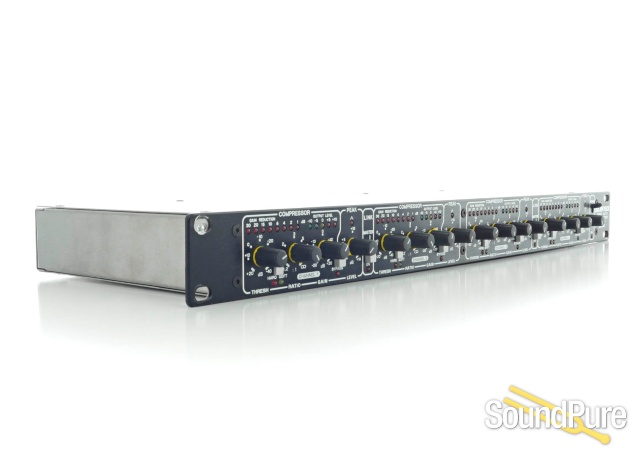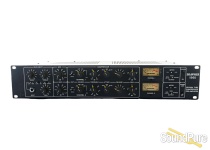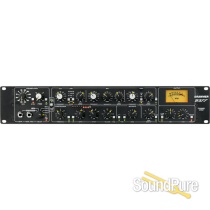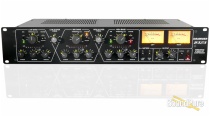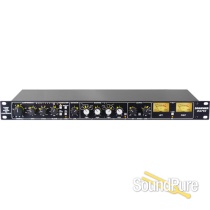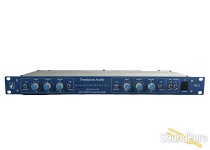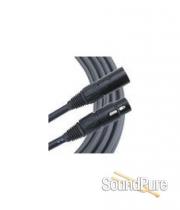-
Call Us Toll Free888-528-9703
-
Local/International (+1)919-682-5552
- Call Us! Toll Free! 888-528-9703
- Local / International (+1) 919-682-5552

"Gone, Baby, Gone"
This one is sold. Don't miss the next one. Some things never even make it to the site so stay up to date on our used collection.
We get in many oddities, rare and vintage products, most of which go fast. If you're on the hunt for something specific, something unique, or something priced right, let us notify you on our used collection before the items even hit the site.
Want to know if one lands?
Notify MeWant to discuss what's coming?
Manufacturer's Description from Drawmer
The DL441 Quad Auto Compressor/Limiter captures four channels of Drawmer's innovative DL241 'Auto Compressor' in only 1U of rack space. The inclusion of new sophisticated 'automated' circuitry allows the engineer to precisely control both the dynamic range and 'absolute' peak level of the programme instantly, without sacrificing essential control parameters. This perfect balance of features makes the DL441 ideal for use in sound reinforcement and outside broadcast applications where an economy in rack space is essential. Each channel combines a fully professional 'Auto Attack/Release' Compressor with a variable threshold 'Peak Level' Limiter on the output providing a transparent 'endstop'. High resolution bar-graph displays on each channel allow gain reduction and output level to be viewed simultaneously, of particular importance in darkened concert hall or control room situations. Facilities available on the DL441 include: Compressor - The compressor section can be switched to provide either HARD or SOFT knee compression In both the HARD and SOFT modes a Ratio control is available. In the SOFT mode the ratio increases gradually over a 10dB input level range until it reaches the ratio set on the front panel control, thus achieving a more natural sounding compression In HARD mode the compressor provides a more precise means of controlling gain, where the ratio as set on the front panel is applied immediately the signal exceeds threshold. This is particularly useful in many broadcast applications. HARD knee compression can also be used creatively as an effect, particularly in the treatment of drum and guitar sounds, or for giving rock vocals a 'compressed sound'. Auto Attack and Release - removes the need for manual adjustment by producing a response which constantly follows the dynamics of the signal. This enables the DL441 to preserve crisp transients without allowing excessive peaks to occur. A smooth yet lively recovery from compression minimizes side effects such as 'pumping' and 'breathing'. This feature is particularly valuable when the program being treated does not have predictable or consistent dynamics, such as complete mixes, vocals or 'slapped and pulled' bass guitar. Peak Level Limiter - 'Zero Response Time', 'Zero Overshoot' circuitry provides an absolute limit to the peak level of the output signal, adjustable from 0db to +16dB above system level. 'Zero Response Time' transparent limiting means that the DL441 provides complete protection from even the fastest and shortest signal overloads, making the unit ideally suited for speaker system protection in sound reinforcement applications. The sophisticated circuitry will also prevent unpleasant distortion when used for digital mastering. Metering - Comprehensive bar graph displays give 'at a glance' indications of gain reduction, and input/output signal level Gain reduction from 1dB to 30dB is shown simultaneously with signal level from 10dB to +10dB. When the channel is in BYPASS the output bar graph displays the input signal level. Other single LEDs indicate function status of Hard/Soft compression, Bypass, Peak Limiting, Linking, and Power on. Bypass - A fully balanced hard-wire bypass connects the input directly to the output allowing signal to pass through the unit with no power applied. Stereo Linking - Channels 1-2 and/or 3-4 can be stereo linked, where the left channel of the stereo pair becomes the master. Operating Level - The operating level of the DL441 can be instantly switched, independently on each channel, for either +4dBu or 10dBu operation using a rear panel push switch. Input/Output - The DL441 is provided with balanced inputs and outputs on XLR connections.
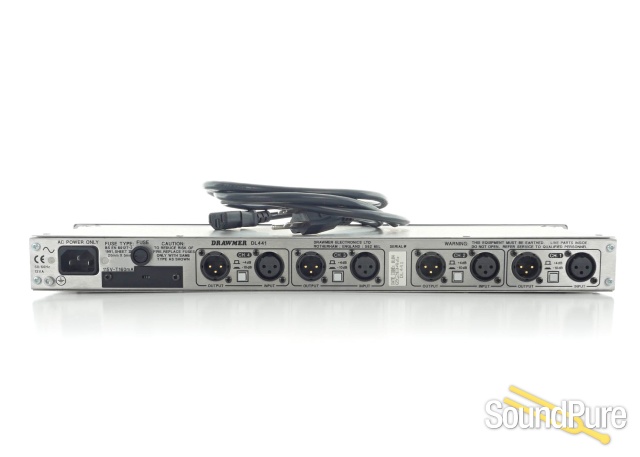
About Manufacturer
Specifications
INPUT IMPEDANCE 20KOhm MAXIMUM INPUT LEVEL +21dBu (+17dB ref. +4dBu) OUTPUT IMPEDANCE 50 Ohm MAXIMUM OUTPUT LEVEL +20dBu BANDWIDTH <12Hz to 35KHz -1dB CROSSTALK @10kHz Better than -80dB @20kHz Better than -75dB OUTPUT BALANCE Better than 40dB 20Hz to 10kHz INPUT CMR Better than 40dB 20Hz to 10kHz NOISE AT UNITY GAIN reference +4dBu Wideband 22Hz - 22KHz CCIR ARM IEC A Q-Pk CCIR AV -90dB -98dB -99dB -100dB -88dB RMS -89dB -96dB -97dB -98dB - DISTORTION 100Hz 1KHz 10KHz Unity Gain, +4dBu Input < 0.02% < 0.015% < 0.035% +14dBu Input, 10dB G.R. < 0.3% < 0.1% < 0.1% POWER REQUIREMENTS 115Volt or 230Volt at 50-60Hz, 13 Watts FUSE RATING 80mA for 230Volt, 160mA for 115Volt CONFORMING TO BS EN 60127-2:1991 SHEETIII FUSE TYPE 20mm x 5mm, Class 3 Slo-Blo, 250Volt working CASE SIZE 482mm (w) x 44mm (h) x 200m WEIGHT (incl packaging) 3.4 Kgs
